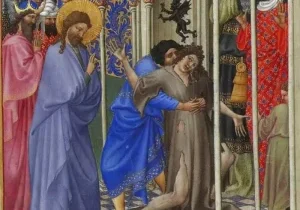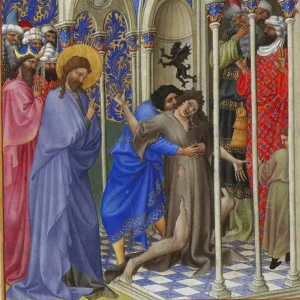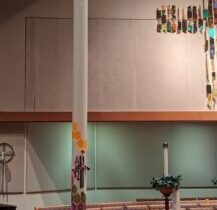Building Up the Body of Christ
Initial Reflections on Deacons and Priests in the Summary Report of the First Session of the XVI Ordinary General Assembly of the Synod of Bishops
Dec4 by Deacon William T. Ditewig, Ph.D.
From – Deacons Today in a Servant Church – Translated with permission
Click on this link for the original English version of this document
Haga clic en este enlace para leer la versión original en Inglés de este documento.
Edificando el Cuerpo de Cristo
4 de diciembre por el diácono William T. Ditewig, Ph.D.
Reflexiones iniciales sobre los diáconos y los presbíteros en el informe resumido de la
Primera Sesión de la XVI Asamblea General Ordinaria del Sínodo de los Obispos
Para el alimento y el crecimiento constante del Pueblo de Dios, Cristo Señor instituyó en su Iglesia
una variedad de ministerios, que trabajan por el bien de todo el cuerpo (Lumen gentium, 18).
 Introducción: Memorias
Introducción: Memorias
El anciano estaba cansado. Habíamos estado realizando una serie de entrevistas durante varias semanas, y la entrevista de hoy lo había agotado mientras recordaba personas y eventos de décadas atrás. Pero las dos últimas preguntas le habían reanimado mientras que se removió en su silla y se inclinó hacia delante para responder. —Obispo —le había preguntado—, dos preguntas más. En primer lugar, durante muchos años, usted solía hablar del Concilio Vaticano II todo el tiempo. En los últimos años, sin embargo, rara vez se habla de ello. ¿Por qué no? En segundo lugar, ¿hay cuestiones que usted cree que los Padres del Concilio pasaron por alto o no enfatizaron tanto como deberían”?
El obispo era el obispo emérito de una diócesis del Medio Oeste. Había asistido a las cuatro sesiones del Concilio Vaticano II como un joven obispo auxiliar recién ordenado. Había accedido a estas entrevistas como una contribución esencial a la historia oral del Consejo. Sus respuestas a estas preguntas fueron particularmente conmovedoras.
—Bueno, Bill, te lo diré. Sus dos preguntas van juntas. La respuesta es una palabra: el sacerdocio”. Explicó que, después del Concilio, había acogido con entusiasmo la aplicación del Consejo. Creó un Consejo Pastoral Diocesano, reestructuró y amplió su personal diocesano y difundió personalmente la noticia del Consejo por toda la diócesis. Sin embargo, no muchos años después del Concilio, la disminución del número de sacerdotes se convirtió en un torrente, y el número de seminaristas se desplomó. A medida que pasaban los años, el obispo comenzó a preguntarse si algo que habían hecho en el Concilio, o no habían hecho, era responsable. Se dio cuenta de que, si bien el Consejo había hecho algunas cosas maravillosas, tal vez pasó por alto alguna cosa.

Por un lado, habían llamado a todas las personas a la perfección en la santidad, habían obligado a los laicos a una mayor participación y corresponsabilidad por la Iglesia, habían avanzado en su propia comprensión de la naturaleza del ministerio episcopal, habían abordado reformas en la vida religiosa e incluso revitalizado un diaconado ejercido permanentemente. Pero los obispos del mundo no se habían referido al sacerdocio de ninguna manera sustantiva. El obispo dijo que el mismo grupo que sería responsable de la implementación pastoral en curso de muchas de las decisiones del Concilio no fue consultado de antemano, no estuvo representado en los debates conciliares y no fue debidamente formado e informado para actualizar la visión y realizar el potencial del Concilio. Los obispos habían asumido la estabilidad general de la naturaleza y el ministerio del sacerdocio. Hasta su muerte, el obispo agonizó por esta laguna y sus efectos.
La XVI Asamblea General Ordinaria del Sínodo de los Obispos
Este recuerdo me vino a la mente mientras leía el Informe de Síntesis de la XVI Asamblea General Ordinaria del Sínodo de los Obispos. Este ensayo se centrará en la Sección 11 del Informe, titulada “Diáconos y sacerdotes en una Iglesia sinodal”. Sin embargo, antes de comenzar, quiero ser claro: yo no podría estar más entusiasmado con el Papa Francisco y su llamado a reconocer, afirmar y expandir el carácter sinodal de la Iglesia. Para que la iglesia peregrina descrita por el Vaticano II continúe su camino hacia el Reino, es esencial un “camino sinodal”. Sin embargo, si el Sínodo fuera un coro, creo que faltarían algunas voces.
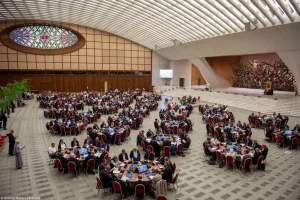
Según todos los testimonios de quienes estuvieron presentes, la Asamblea General de 2023 fue una experiencia positiva y agotadora. La Secretaría del Sínodo de la Santa Sede se enfrentó a un desafío hercúleo: identificar a los participantes y a los actores de apoyo que representan a la Iglesia universal en todo su rico tapiz de laicos, religiosos y clérigos. Los delegados fueron elegidos por las conferencias episcopales, de las Iglesias Católicas Orientales, líderes seleccionados de la Curia Romana y 120 delegados seleccionados personalmente por el Papa Francisco. En total, 363 personas fueron miembros con derecho a voto, incluidas 54 mujeres. Además de los miembros con derecho a voto, otros 75 participantes actuaron como facilitadores, expertos o asistentes espirituales. Desde el punto de vista de la planificación, la oficina del Sínodo hizo un gran trabajo al reunir a un equipo de participantes impresionantemente diverso.
Al mismo tiempo, muchos observadores han observado lagunas significativas en la lista de participantes. Había, por ejemplo, sólo dos diáconos en la asamblea, uno diácono de Bélgica y otro de Siria que está a punto de ser ordenado presbítero. Otros señalan una grave falta de párrocos en la Asamblea. Otros destacaron la ausencia de los pobres, y otros comentaristas han señalado la falta de influencia sustancial de los expertos teológicos que asistieron a la Asamblea en contraste con el impacto significativo de los periti teológicos y canónicos en el Vaticano II. Todas estas áreas, y más, merecen un análisis y estudio adicionales. El enfoque de este ensayo en la Sección 11 no debe entenderse como una sugerencia de que estas son las únicas o incluso las más notables áreas de investigación. El propósito de la sinodalidad es caminar juntos, escuchar, compartir y discernir juntos. Parece que, si uno se encuentra hablando de otra persona en lugar de con otra persona, entonces se ha encontrado una debilidad estructural en el proceso. Consideremos un ejemplo bien conocido. Unción sacerdotal

Del mismo modo, podríamos señalar las discusiones sobre los diáconos y el diaconado, en las que los diáconos no tenían voz, o las discusiones sobre los sacerdotes y el sacerdocio, en las que los párrocos no tenían voz. Como se mencionó anteriormente, dos diáconos estuvieron presentes en la Asamblea General. Sí, había sacerdotes presentes, pero ¿cuántos servían como párrocos? La preocupación no es solo que los diáconos y sacerdotes tengan la oportunidad de ser escuchados, sino que, lo que es más importante, están obligados a escuchar de primera mano las voces que los rodean. Al igual que un coro, los cantantes deben escucharse unos a otros. La esperanza es que, a medida que continuamos por el camino sinodal, se puedan encontrar formas de seguir sumando voces al coro. ¿Qué es mejor: hablar de un tenor o escuchar uno?
Hace algunos años, la Conferencia de Obispos Católicos de los Estados Unidos (USCCB, por sus siglas en inglés) trabajó en un borrador de documento sobre el papel de la mujer en la Iglesia. Pasó por muchos borradores, sesiones de escucha y más borradores. Finalmente, después de años de esfuerzo, los obispos desecharon el proyecto. Los obispos se dieron cuenta de que el documento hablaba de las mujeres y de la Iglesia como si fueran dos cosas distintas: las mujeres por un lado y la Iglesia por el otro. Si un grupo de hombres convocara una reunión para hablar sobre las mujeres, y ninguna mujer formara parte de esas conversaciones, veríamos inmediatamente la debilidad del enfoque.
Me viene a la mente el viejo obispo. Llegó a creer que se había equivocado al no darse cuenta de cómo las reformas e iniciativas del Vaticano II afectarían al sacerdocio. El sacerdocio permanecería, pensó, relativamente sin cambios, mientras que todo lo demás alrededor del sacerdote estaba cambiando. Sólo después del Concilio, él y otros obispos se dieron cuenta de que sus sacerdotes no estaban preparados para ser el tipo de líderes pastorales responsables de implementar las visiones del Concilio. Podríamos compartir esa preocupación en el proceso sinodal en curso. Los ministros que ayudarán a crear y servir en una Iglesia sinodal deben participar en el proceso formal para que sus voces y experiencias puedan ser escuchadas y puedan aprender directamente de las experiencias de los demás. Tienen tanto el derecho a ser escuchados como la obligación de escuchar, la responsabilidad de responder con humildad, considerando a los demás como mejores que ellos mismos, mirando no a sus propios intereses, sino a los intereses de los demás (Filipenses 2:3-4).
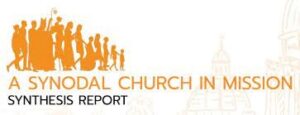
Sección 11 del informe de síntesis
La sección 11 se compone de tres secciones: Convergencias (4), Cuestiones a abordar (2) y Propuestas (6).
Convergencias
Las cuatro “convergencias” abordan la naturaleza y el ejercicio del ministerio ordenado, una declaración general positiva de la diversidad y la calidad del servicio que ofrece actualmente el clero, una preocupación crítica sobre el clericalismo y, finalmente, cómo la formación conduce a una conciencia de las propias limitaciones, así como de las propias fortalezas, puede ayudar a superar el clericalismo.
El primer punto de convergencia describe a los diáconos y presbíteros de la siguiente manera: “Los presbíteros son los principales cooperadores del Obispo y forman con él un solo presbiterio; los diáconos, ordenados para el ministerio, sirven al Pueblo de Dios en la diaconía de la Palabra, de la liturgia, pero sobre todo de la caridad”.
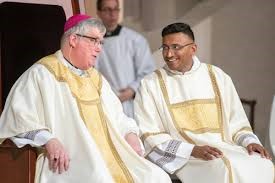
En general, esta frase no es sorprendente. Aun así, me gustaría observar que la historia del diaconado (especialmente el registro patrístico) destaca constantemente el vínculo único entre los diáconos y su obispo. Es tan singular que cuando un diácono es ordenado, solo el obispo impone las manos sobre el ordenando, a diferencia de la ordenación de presbíteros y obispos en la que todos los sacerdotes asistentes imponen las manos sobre los nuevos sacerdotes y todos los obispos asistentes imponen las manos sobre los nuevos obispos. El contraste es sorprendente y significativo: el diácono tiene una relación única y especial con su obispo. Por supuesto, los presbíteros tienen su fraternidad sacerdotal única con el obispo, pero la omisión de la relación del diácono con el obispo es desafortunada.
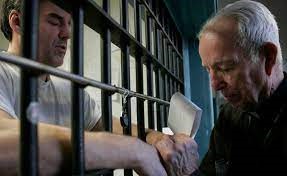
Diácono y Ministerio Carcelario
En segundo lugar, la descripción del ministerio del diácono habla del triple munus de la Palabra, de la Liturgia, “pero sobre todo de la caridad”. Si bien es cierto que la caridad es característica del diácono y el ministerio diaconal, es el “sobre todo” lo que suscita una preocupación. La experiencia pastoral y el análisis teológico desde la renovación del diaconado hace casi sesenta años han desarrollado la comprensión de que los tres munera deben ser equilibrados e integrados. La posición de la Conferencia de Obispos Católicos de los Estados Unidos ha sido que las tres funciones están inherentemente interrelacionadas y que nadie que no sea competente en las tres áreas debe ser ordenado. Algunos teólogos han descrito la relación de las funciones como pericoréticas y no simplemente funciones discretas en sí mismas. Es un hecho común que los diáconos y sus formadores hablen de la metáfora del “taburete de tres patas”: si las tres patas están desequilibradas, el diácono caerá.
El Informe también destaca la preocupación de que los diáconos valoran y ejercen su papel litúrgico y sacramental a expensas o descuido del servicio caritativo. Eso, por supuesto, es una preocupación razonable. Por otra parte, parece que la misma identidad sacramental del diácono se encuentra en un ejercicio equilibrado del triple munus. Uno podría decirlo de otra manera: así como sería incorrecto que un diácono ejerciera su función litúrgica exclusivamente sin ministerio caritativo, sería igualmente incorrecto que un diácono trabajara solo en esfuerzos caritativos y no llevara ese trabajo al púlpito o al santuario. A lo largo de los años del diaconado renovado, muchos escritores han subrayado correctamente el ejercicio equilibrado de la Palabra, la Liturgia y la Caridad.

El segundo punto de convergencia se refiere a las diversas formas de ministerio pastoral que actualmente ejercen sacerdotes y diáconos. Es un buen resumen, y su descripción de un enfoque sinodal del ministerio ordenado es particularmente acertada. Abre la discusión al siguiente punto de convergencia: los peligros del clericalismo.
En esta tercera área, el clericalismo es descrito como “un obstáculo para el ministerio y la misión” y “una deformación del sacerdocio”. Si bien el párrafo habla en términos generales de clericalismo, yo sugeriría que todos los comentarios centrados en la formación sacerdotal y la actitud hacia el poder sobre el servicio deberían dirigirse explícitamente a todos los que sirven: obispos, presbíteros, diáconos, religiosos y laicos.
El cuarto y último punto de convergencia pone el acento en “un camino de autoconocimiento realista” en todos los niveles de formación para el ministerio ordenado. Una vez más, el término asociado con el Vaticano II, corresponsabilidad, describe el enfoque deseado del ministerio, marcado por un “estilo de corresponsabilidad”. La formación humana debe ayudar a los candidatos a la ordenación (diáconos y presbíteros) a ser conscientes de sus límites humanos, así como de sus capacidades. En particular, el uso del lenguaje es inclusivo para todos los ordenados y no se limita a la formación sacerdotal. También es significativo el aprecio por la familia de origen del candidato y el papel de la comunidad de fe en este proceso, que ha fomentado la vocación al ministerio ordenado.
Cuestiones que deben abordarse
A raíz de estos cuatro puntos de convergencia, se plantean dos cuestiones concretas. El primero se refiere a la formación específica de diáconos y presbíteros para una Iglesia sinodal, y el segundo se refiere al celibato sacerdotal para los sacerdotes de la Iglesia latina.
En los Estados Unidos, la Conferencia de Obispos Católicos de los Estados Unidos (USCCB, por sus siglas en inglés) ha emitido y revisado una serie de normas de formación tanto para diáconos como para sacerdotes durante varias décadas. Si bien hay similitudes significativas en el contenido de la formación (especialmente en la dimensión intelectual), el contexto de la formación de los diáconos es muy distinto del de los sacerdotes. El programa para la formación de diáconos es una responsabilidad diocesana, aumentada en la medida de lo posible o necesaria por asociaciones con institutos católicos de educación superior. En lugar de ir “al seminario”, la formación de diáconos se lleva a cabo en lugares diocesanos, generalmente por las noches y los fines de semana, ya que la mayoría de los candidatos para diácono están criando familias y trabajando en carreras y profesiones seglares.
En este sentido, pues, la formación de los diáconos está ya “ligada a la vida cotidiana de las comunidades”. Esto no quiere decir que una revisión continua del proceso general de formación de diáconos sea innecesaria para “evitar los riesgos de formalismo e ideología que conducen a actitudes autoritarias”. Tanto los procesos de formación de los seminarios como los diocesanos se beneficiarán de la llamada del Sínodo a una reevaluación amplia y creativa.
La segunda cuestión, relativa al celibato sacerdotal, es sencilla y es un tema que se ha discutido durante mucho tiempo. ¿Es cierto que el valor global del celibato “se traduce necesariamente en una obligación disciplinaria en la Iglesia latina”? Si bien puede ser apropiada una reflexión adicional, parecería ser un momento oportuno para pasar a la implementación de un programa ad experimentum en varios lugares en los que los candidatos casados para la ordenación presbiteral sean admitidos a la formación y posible ordenación al presbiterio.
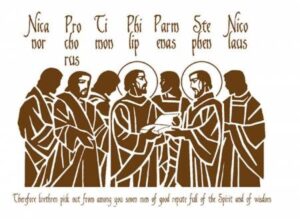
Propuestas
Seis propuestas concluyen la sección. Tres de ellos se centran en el diaconado. Los resumiré antes de comentarlos en globo.
La primera propuesta recomienda una evaluación “de la implementación del ministerio diaconal después del Concilio Vaticano II”, citando la implementación desigual del diaconado. Se mencionan varias preocupaciones. En primer lugar, algunas regiones no lo han introducido en absoluto. Otros temen que el diaconado pueda ser malinterpretado como un intento de “remedio” para la escasez de sacerdotes. A otros les preocupaba que “a veces su ministerialidad se expresa en la liturgia más que en el servicio a los pobres y necesitados”. El punto esencial es sólido: la implementación de un diaconado renovado ha sido desigual.
En segundo lugar, el Sínodo identifica la necesidad de “entender el diaconado ante todo en sí mismo, y no sólo como una etapa de acceso al sacerdocio”. Señala la distinción lingüística que a veces se hace entre los llamados diáconos “permanentes” y “transitorios” como un signo de la falta de descripción del diaconado en sus propios términos. En tercer lugar, las “incertidumbres que rodean la teología del ministerio diaconal” revelan la necesidad de “una reflexión más profunda”, que “arroje luz también sobre la cuestión del acceso de las mujeres al diaconado”.
Las tres propuestas tienen mérito y deben ser llevadas a cabo con entusiasmo, de manera sistemática y comprensiva. Sin embargo, el texto de las propuestas sugiere que esa evaluación no se ha llevado a cabo ya en varios lugares. Los documentos de la Santa Sede (publicados en 1998) y de las diversas conferencias episcopales han citado durante mucho tiempo estas áreas de preocupación. La Santa Sede publicó las Normas Básicas para la Formación de los Diáconos Permanentes conjuntamente con el Directorio para el Ministerio y la Vida de los Diáconos Permanentes, que ofrecían una importante orientación teológica y canónica sobre la renovación del diaconado. Casi desde el comienzo de la renovación del diaconado en los Estados Unidos en 1968, la Conferencia de Obispos ha llevado a cabo evaluaciones periódicas sobre estos y otros temas relacionados.
Por ejemplo, una serie significativa de estudios realizados por la Conferencia de Obispos Católicos de los Estados Unidos en 1995 dio como resultado que la Conferencia cambiara el nombre del comité de obispos responsable del diaconado renovado para eliminar la palabra “permanente”, cambiando la Secretaría (y el Comité) del Diaconado Permanente a la Secretaría (y el Comité) del Diaconado en reconocimiento del punto teológico de que hay un diaconado. Sacramentalmente, ninguna ordenación es “transitoria”: una vez ordenado diácono, uno sigue siendo diácono. Como he escrito en otro lugar, no nos referimos a un presbítero que luego se convierte en obispo como un sacerdote “transitorio”; sigue siendo sacerdote. Un diácono sigue siendo diácono, incluso si más tarde es ordenado presbítero u obispo. Una práctica relacionada con este asunto que necesita una revisión seria es el uso continuo del “modelo de aprendiz del diaconado” de ordenar seminaristas al diaconado antes de la ordenación al presbiterio. Esta práctica sigue distorsionando las posibilidades de que el diaconado se ejerza en una iglesia sinodal.
Finalmente, la Conferencia de Obispos Católicos de los Estados Unidos (USCCB, por sus siglas en inglés) y otras conferencias episcopales han publicado Directorios nacionales sobre la formación, el ministerio y la vida de los diáconos. Además de estos esfuerzos magisteriales, teólogos de todo el mundo han estudiado, enseñado y escrito extensamente sobre estos temas.
Enumero estas fuentes para contrarrestar la posible implicación de las palabras del Sínodo de que la evaluación que está pidiendo sería algo nuevo. Durante décadas se ha llevado a cabo un importante trabajo pastoral y teológico, y este trabajo fundacional podría servir bien al llamado sinodal contemporáneo para una “evaluación más profunda”. Cualquier nueva evaluación de este tipo tendrá una base sólida sobre la cual construir.
Las propuestas cuarta y quinta implementan la discusión anterior sobre la naturaleza y el contenido de la formación del clero, incluido el desarrollo de “procesos y estructuras que permitan la verificación regular de las formas en que los sacerdotes y diáconos que desempeñan funciones de responsabilidad ejercen el ministerio”. La clave sería contar con formas de participación de la comunidad local en estas estructuras. Si bien estas son propuestas bienvenidas, se podría sugerir que el proceso de pedir comentarios y evaluación se amplíe para incluir el episcopado, el presbiterio y el diaconado. La propuesta final también es sencilla y debe implementarse fácilmente, brindando una “oportunidad de incluir a los sacerdotes que han dejado el ministerio en un servicio pastoral que mejore su formación y experiencia”.
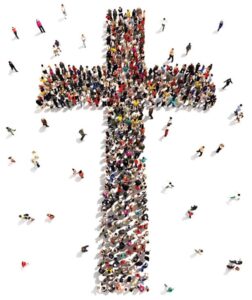
Conclusión
¿Habría tenido un impacto la presencia de diáconos y presbíteros adicionales en la Asamblea General en alguna de estas y otras preguntas relacionadas? No podemos saberlo, pero uno esperaría que hubiera aportado algo de valor al proceso. A medida que se desarrollen y mejoren las estrategias sinodales en toda la Iglesia, se espera que los diáconos y sacerdotes ayuden y apoyen el proceso en conjunto con todos los demás. Es esencial que los corazones, las manos y las voces de los diáconos y párrocos formen parte del coro de fieles que ahora están comprometidos en el discernimiento de una futura Iglesia sinodal. Si nos encontramos hablando de otras personas en lugar de hablar con ellas, hemos llegado a un punto peligroso. Todos estamos llamados a orar, escuchar, discernir y prestar nuestro corazón y nuestras manos para construir una Iglesia sinodal.
Share this (Compártelo):
Related (Relacionado)
Deacons and the Synod, Part Two: A Path Forward 24 July 2023 In “Changing the Church” (En “Cambiar la Iglesia”) (Los diáconos y el Sínodo, Segunda parte: un camino a seguir)
Deacons and the Synod, Postscript: Prayer, Reflection 16 August 2023 In “Deacons” (En “Diáconos”) (Los diáconos y el Sínodo, Posdata: oración, reflexión discernimiento)
Deacons and the Synod, Part One: “Father, Where Are You Going Without Your Deacon? 17 July In “Deacons” (En “Diáconos”) (Los diáconos y el Sínodo, primera parte: “Padre, ¿A dónde vas sin tu diacono”?)
This entry was posted in Authority, Changing the Church, Deacons, Leadership, Pope Francis, Priests, Servant Leadership, Synod on Synodality, The Church.
(Esta entrada fue publicada en Autoridad, Cambiando la Iglesia, Diáconos, Liderazgo, Papa Francisco, Sacerdotes, Liderazgo de Servicio, Sínodo sobre la Sinodalidad , La Iglesia.)
Read More
 Our first lesson in morality is the one we hear as infants. “Say thank you.”
Our first lesson in morality is the one we hear as infants. “Say thank you.” 





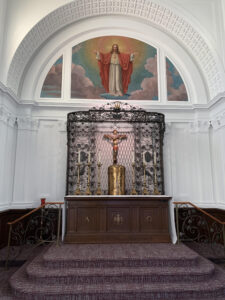
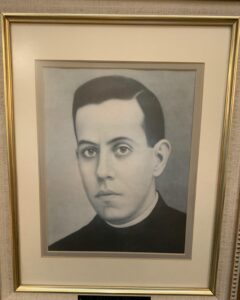
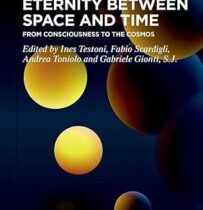
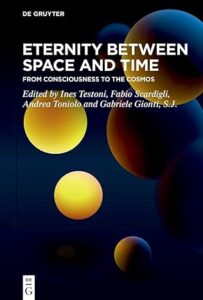 Eternity Between Space and Time: From Consciousness to the Cosmos
Eternity Between Space and Time: From Consciousness to the Cosmos